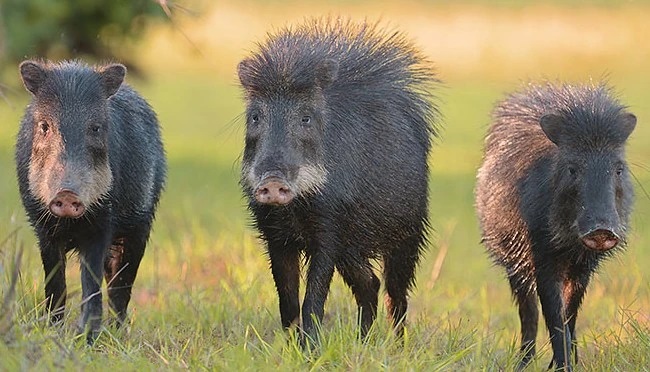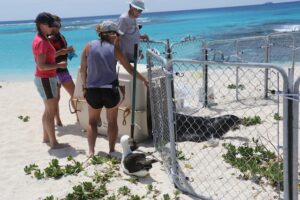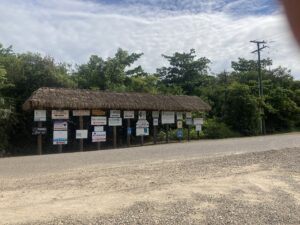In the dense, verdant forests of Belize, a fascinating creature roams in groups, leaving its mark on the ecosystem with its distinctive presence. The White-lipped Peccary, known for its striking white lips and sociable nature, is a captivating mammal that plays a crucial role in the region’s ecology. From its unique features to its complex social dynamics and the challenges it faces in a changing environment, this article delves into the world of the White-lipped Peccary, offering insights into one of Belize’s most intriguing forest inhabitants.
The Enigmatic White-lipped Peccary: A Fascinating Forest Dweller
The White-lipped Peccary (Tayassu pecari) stands out among Belize’s wildlife not just for its distinctive appearance but also for its role as a vital forest dweller. With a compact, robust body covered in coarse, dark brown fur, this pig-like mammal is instantly recognizable by its most striking feature—the prominent white stripe that adorns its upper lip, giving it the name “White-lipped” Peccary. This unique marking serves not only as a visual identifier but also as a key element in its social interactions within the forest.
One of the most intriguing aspects of the White-lipped Peccary is its omnivorous diet, which includes fruits, nuts, roots, and occasionally small animals like insects and reptiles. This varied diet makes it a crucial component of Belize’s ecosystem, contributing to seed dispersal and nutrient cycling in the forest. As opportunistic foragers, they play a significant role in maintaining the balance of plant and animal species within their habitat.
Despite their relatively small size compared to other large mammals, White-lipped Peccaries are formidable creatures, equipped with strong jaws and sharp tusks that they use for digging and defense. Their ability to navigate through dense vegetation and their agility in escaping predators make them well-adapted to the challenges of their forest environment.
What sets the White-lipped Peccary apart from solitary mammals is its highly social nature. These animals form tight-knit groups known as “sounders,” typically consisting of 20 to 30 individuals, although larger groups have been observed. Within these sounders, complex social hierarchies and communication systems exist, involving vocalizations, scent marking, and body language to coordinate foraging activities and protect against threats.
Despite their resilience and adaptability, White-lipped Peccaries face numerous challenges in Belize, including habitat loss due to deforestation, hunting pressures, and human-wildlife conflicts. Understanding their ecology and behavior is crucial for implementing effective conservation strategies to ensure the long-term survival of this fascinating forest dweller.
Group Dynamics: Understanding the Social Behavior of Peccary Sounders
The social structure of White-lipped Peccaries is a fascinating aspect of their biology, shaping their interactions, foraging patterns, and survival strategies within Belize’s forests. At the core of their social organization is the “sounder,” a cohesive group comprising individuals of varying ages and sexes, led by dominant females known as “matriarchs.” These sounders play a crucial role in the daily lives and long-term survival of White-lipped Peccaries.
Within a sounder, hierarchical dynamics are evident, with matriarchs holding the highest rank and exerting influence over group movements, feeding preferences, and territorial defense. This hierarchical structure ensures efficient decision-making and coordination during activities such as foraging for food or responding to threats from predators.
Communication is essential in maintaining cohesion within a sounder, and White-lipped Peccaries employ a range of vocalizations, including grunts, squeals, and chattering sounds, to convey information and maintain social bonds. These vocalizations serve various purposes, from signaling danger to coordinating group movements and expressing dominance or submission within the hierarchy.
Scent marking also plays a significant role in the social dynamics of White-lipped Peccaries. Individuals use specialized glands located on their faces and bodies to leave scent marks on trees, rocks, and other objects in their environment. These scent marks contain information about the individual’s identity, reproductive status, and group affiliation, helping to reinforce social bonds and establish territorial boundaries.
Group cohesion and cooperation are critical for the survival of White-lipped Peccaries, especially during times of scarcity or when facing predators. By foraging together and relying on collective vigilance, they enhance their chances of finding food, detecting threats, and defending against potential dangers.
Understanding the intricate social behavior of White-lipped Peccaries provides valuable insights into their ecology and conservation needs. Preserving their natural habitats and minimizing human disturbances are essential steps in ensuring the continued existence of these highly sociable forest foragers in Belize’s diverse ecosystems.
Conservation Challenges: Protecting the White-lipped Peccary’s Habitat in Belize
The White-lipped Peccary faces a range of conservation challenges in Belize, highlighting the delicate balance between human activities and preserving the natural environment that these fascinating mammals call home. One of the primary threats to their survival is habitat loss due to deforestation and land conversion for agriculture, logging, and infrastructure development. As forests shrink and fragmented habitats become more common, White-lipped Peccaries face increased competition for resources and reduced connectivity between populations, leading to genetic isolation and decreased genetic diversity.
Human-wildlife conflicts also pose significant challenges to White-lipped Peccaries in Belize. Encounters with humans, whether through agricultural expansion, hunting, or road development, can result in direct conflicts that threaten both the animals and human communities. Peccaries may raid crops, leading to retaliatory killings by farmers, while roads and human settlements fragment their habitats and increase the risk of vehicle collisions.
Illegal hunting and poaching for bushmeat and traditional medicinal purposes further exacerbate the pressure on White-lipped Peccary populations. Despite legal protections in place, enforcement of regulations can be challenging, particularly in remote or inaccessible areas where poaching activities may go undetected.
Climate change presents additional threats to the White-lipped Peccary and its habitat in Belize. Changes in temperature and precipitation patterns can alter vegetation dynamics, affecting food availability and water sources for these animals. Increased frequency and intensity of extreme weather events, such as hurricanes and droughts, can also disrupt ecosystems and exacerbate existing conservation challenges.
Addressing these conservation challenges requires a multifaceted approach that integrates habitat protection, sustainable land use practices, community engagement, and effective law enforcement. Collaborative efforts between government agencies, conservation organizations, local communities, and researchers are essential for implementing conservation strategies that safeguard the White-lipped Peccary’s habitat and ensure the long-term survival of this iconic species in Belize’s rich natural heritage.
Final Thoughts
The White-lipped Peccary embodies the intricate web of life in Belize’s forests, where its existence is intertwined with the health of ecosystems and the well-being of local communities. As we reflect on the complexities of this species and the challenges it faces, several key considerations emerge.
Firstly, conservation efforts must prioritize habitat protection and restoration to safeguard the White-lipped Peccary’s essential ecological functions. Preserving large tracts of intact forest and establishing wildlife corridors are critical steps in maintaining connectivity between populations and promoting genetic diversity.
Secondly, addressing human-wildlife conflicts requires a collaborative approach that involves local communities in conservation decision-making processes. Empowering communities with sustainable livelihood options, promoting coexistence strategies, and raising awareness about the importance of wildlife conservation can help mitigate conflicts and foster positive relationships between humans and peccaries.
Thirdly, combating illegal hunting and poaching demands increased enforcement of wildlife protection laws, strengthened monitoring and surveillance mechanisms, and targeted educational campaigns to reduce demand for peccary products.
Lastly, climate change adaptation and resilience strategies are essential for ensuring the White-lipped Peccary’s ability to withstand environmental pressures. This includes monitoring and mitigating climate-related impacts on habitats, implementing climate-smart conservation practices, and integrating climate change considerations into conservation planning.
By embracing these final thoughts and taking concerted action, we can contribute to the preservation of the White-lipped Peccary and the rich biodiversity of Belize’s forests for generations to come. Together, we can protect these remarkable forest dwellers and uphold the interconnectedness of all life forms in our natural world.




